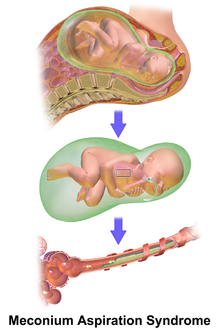This in turn may lead to meconium aspiration syndrome MAS by obstruction of airways by meconium loss of lung surfactant and chemical pneumonitis. Meconium aspiration syndrome in neonates is associated with high 26 mortality.

Meconium Aspiration Syndrome Wikipedia
Aging of the placenta if the pregnancy goes far past the due date.

Risk factors associated with meconium aspiration syndrome. Anemia during pregnancy PIH and GDM were important risk factor associated with MAS. Nonreassuring or abnormal CTG and low Apgar score at the first minute were established as risk factors for MAS and need of surfactant therapy as a predictor of severity. An observational study was conducted in 12 public hospitals in Nepal from 1 July 2017 to 29 August 2018.
Meconium is the earliest stool of a newborn. Results between groups the Meconium Aspiration Syndrome MAS group the meconium in the lower vocal cords but no Meconium Aspiration Syndrome MLVC group and the MSAF group were compared. Thick Meconium stained amniotic fluid was associated with low APGAR score high rate of emergency cesarean section and meconium aspiration syndrome.
While a longer duration of the second stage of labor was significantly associated with mildmoderate MAS severe MAS was associated with a shorter duration of the second stage. This syndrome can be a cause of acute illness and even death in a few newborns. Babies who were diagnosed as MAS were designated as.
The aim of this study was to identify the incidence risk factors and outcome associated with meconium aspiration syndrome MAS. Myocardial dysfunction and higher initial oxygen requirement is associated with higher mortality whereas a higher birth weight is associated with decreased mortality. All babies born within the study period were included in the study.
Meconium aspiration syndrome Meconium stained amniotic fluid gestational diabetes INTRODUCTION. Meconium refers to the first stool or faeces of the newborn. Soon after birth infants present with respiratory distress.
Factors that have been associated with an increased risk for mas are heavy meconium- stained af34 the discovery of meconium in the active phase of laboros nulliparity6 post-dates growth retardation postmaturity7 fetal heart abnormalities during labor308 male gender6low apgar scores9 neonatal acidosis8 and the presence of meconium below. Meconium aspiration syndrome MAS is the neonatal respiratory distress that occurs in a newborn in the context of MASF when respiratory symptoms cannot be attributed to another. The major risk factors for meconium-stained amniotic liquid MSAF and MAS include post maturity in 34 of cases presence of fetal heart rate FHR irregularities in the intrapartum period in 51 of cases cesarean birth in 42 cases fetal distress in 77 and intrauterine growth restriction IUGR in 6 of cases 1.
These pulmonary effects cause gross ventilation-perfusion mismatching. The vicious cycle of hypoxemia shunting acidosis and pulmonary hypertension is frequently associated with MAS and may be difficult or impossible to treat successfully. Several fetal conditions associated with a higher risk of developing PPHN in MAS such as fetal hypoxemia acidosis atelectasis and pulmonary smooth muscle hyperplasia resulting in.
They required significantly more days of oxygen therapy mechanical ventilation nitric oxide inotropic and surfactant therapy as well as longer hospital stay. Occasionally newborns pass meconium during labor or delivery resulting in a meconium-stained amniotic fluid MSAF. Looking at multiple prediction models an infant with fetal distress Apgar.
The aim of this study was to compare the risk factors associated with mildmoderate meconium aspiration syndrome MAS with those associated with severe in meconium-stained term neonates. Numerous risk factors for MAS and foetal hypoxiaischaemia have been identified including post-term pregnancy foetal distress low birth weight mode of delivery low Apgar scores and low cord blood pH710. All babies born within the study period were included in the study.
It may increase the risk of bacterial infection aspiration of meconium resulting in gasping breathing pattern causing hypoxia due to airway obstruction chemical pneumonitis and pulmonary hypertension7The exposure of respiratory tract to the. It can cause breathing problems due to swelling inflammation in the babys lungs after birth. An observational study was conducted in 12 public hospitals in Nepal from 1 July 2017 to 29 August 2018.
Risk factors that may cause stress on the baby before birth include. Infants born through meconium-stained amniotic fluid are at risk of developing meconium aspiration syndrome particularly in the presence of maternal and fetal risk factors. If these risk factors are not present there is a 08 risk.
We compared the risk factors associated with MAS including pattern of fetal heart beat mode of delivery apgar score sex gestational age birth body weight in born or out born infants resuscitation before admission first pH at admission asphyxia surfactant usage pneumothorax pulmonary hemorrhage and shock before the diagnosis of PPHN between PPHN and non. Methods Consecutive singleton term neonates n671 with meconium staining at birth from all deliveries n14666 in our institution from January 2006. Presence of meconium in the amniotic fluid could be a dangerous condition.
Retrospective study including newborns admitted between 2005 and 2015 with a diagnosis of MAS. 8 rows Other studies have shown that pregnancy-associated hypertension pre-eclampsia and eclampsia are. Risk factors associated with pregnancy delivery and the neonates condition were identified.
The frequencies of nulliparity fetal tachycardia and intrapartum fever were significantly increased in the mildmoderate MAS group but not in the severe MAS group. The meconium can also block the infants airways right after birth. To identify risk factors and predictors of severity associated with meconium aspiration syndrome MAS in the patients admitted to the neonatal intensive care unit NICU.
The aspiration of meconium stained amniotic fluid by the fetus can happen during antepartum or intrapartum periods and can result in airway obstruction interference with alveolar gas exchange chemical pneumonitis as well as surfactant dysfunction. The aim of this study was to identify the incidence risk factors and outcome associated with meconium aspiration syndrome MAS. The MAS or the Meconium Aspiration Syndrome occurs when a newborn is over the due date and inhales a mixture of meconium and amniotic fluid in the lungs at the time of labour or in the womb.
Logistic regression analysis identified four independent risk factors.

Meconium Aspiration Syndrome Causes And Effects
Tidak ada komentar